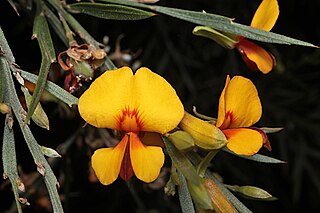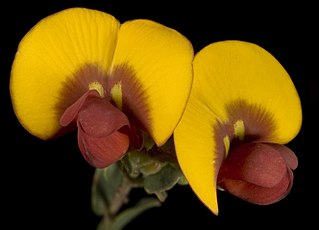
Jacksonia sericea, commonly known as waldjumi, is a species of flowering plant in the family Fabaceae and is endemic to the south-west of Western Australia. It is a spreading to prostrate shrub with greyish-green branches, straight, sharply-pointed side branches, leaves reduced to scales, orange flowers with red markings, and woody, densely hairy pods.

Jacksonia lehmannii is a is a species of flowering plant in the family Fabaceae and is endemic to the south-west of Western Australia. It is an erect to prostrate or spreading, spindly shrub with greyish-green branches, sharply-pointed side branches, its leaves reduced to scales leaves, yellowish-orange flowers with orange-red markings, and woody, hairy pods.

Jacksonia horrida is a species of flowering plant in the family Fabaceae and is endemic to the south-west of Western Australia. It is an erect or spreading to prostrate, bushy shrub with greyish-green branches ending in short, flattened, sharply-pointed side branches, the leaves reduced to scales and the flowers scattered and yellow-orange with red markings.

Daviesia hakeoides is a species of flowering plant in the family Fabaceae and is endemic to the south-west of Western Australia. It is a shrub with many tangled stems, scattered sharply-pointed phyllodes and yellow or orange and dark red flowers.
Bossiaea preissii is a species of flowering plant in the family Fabaceae and is endemic to the south of Western Australia. It is a compact, glabrous shrub with egg-shaped leaves with the narrower end towards the base, and yellow, red, orange or apricot-coloured flowers.

Bossiaea pulchella is a species of flowering plant in the family Fabaceae and is endemic to the south-west of Western Australia. It is a slender, erect shrub with egg-shaped leaves, and orange-yellow, purplish brown and dark red flowers.
Chorizema rhynchotropis is a species of flowering plant in the family Fabaceae and is endemic to the southwest of Western Australia. It is a straggling, sprawling or erect shrub with linear, sharply-pointed leaves, and orange or red and pink and yellow pea flowers.

Jacksonia acicularis is a species of flowering plant in the family Fabaceae and is endemic to the west of Western Australia. It is an erect, spindly shrub with very sharply-pointed short side branches, leaves reduced to scales, orange flowers with red markings, and densely hairy pods.

Jacksonia angulata is a species of flowering plant in the family Fabaceae and is endemic to the south-west of Western Australia. It is a tufted, spreading to prostrate shrub often with zig-zagged branches, sharply-pointed side branches or phylloclades, leaves reduced to broadly egg-shaped scales, yellow-orange to orange flowers with a red "eye", and woody, densely hairy pods.

Jacksonia arenicola is a species of flowering plant in the family Fabaceae and is endemic to the south-west of Western Australia. It is an erect, broom-like shrub with densely hairy, sharply-pointed phylloclades, yellow-orange flowers with red markings, and woody pods that are hairy at first, later glabrous.

Jacksonia calcicola is a species of flowering plant in the family Fabaceae and is endemic to the south west of Western Australia. It is a prostrate spreading or erect, prickly shrub with short, curved backwards and sharply pointed end branches, yellow-orange flowers with red markings, and woody, hairy pods.
Jacksonia calycina is a species of flowering plant in the family Fabaceae and is endemic to the south west of Western Australia. It is an erect or straggling shrub with sharply pointed end branches, yellow-orange flowers with red and yellow markings, and woody, hairy pods.

Jacksonia compressa is a species of flowering plant in the family Fabaceae and is endemic to the south west of Western Australia. It is an erect, bushy shrub with sharply pointed end branches, yellow-orange flowers with red markings, and woody, hairy pods.

Jacksonia debilis is a species of flowering plant in the family Fabaceae and is endemic to the south west of Western Australia. It is a spreading to prostrate shrub with curved phylloclades, yellow-orange flowers with red markings, and woody, hairy pods.
Jacksonia dendrospinosa is a species of flowering plant in the family Fabaceae and is endemic to the far west of Western Australia. It is a dense, erect shrub or tree with straight, sharply-pointed branches, leaves reduced to scales, scattered yellow-orange flowers with red markings, and membranous, hairy pods.
Jacksonia epiphyllum is a species of flowering plant in the family Fabaceae and is endemic to the south of Western Australia. It is an erect or straggling shrub, the end branches egg-shaped or elliptic phylloclades, the leaves reduced to scale leaves, the flowers yellow-orange with red markings, and woody, densely-hairy pods.
Jacksonia eremodendron is a species of flowering plant in the family Fabaceae and is endemic to the south-west of Western Australia. It is a straggling shrub to small tree, the end branches egg-shaped, elliptic or oblong phylloclades with sharply-pointed teeth on the edges, the flowers yellow-orange with red markings and attached to teeth on phylloclades, and woody, densely-hairy pods.

Jacksonia fasciculata is a species of flowering plant in the family Fabaceae and is endemic to the south-west of Western Australia. It is an erect, spiny shrub with sharply-pointed end-branches, leaves reduced to scales and orange flowers with red markings in the axils of branches.

Jacksonia forrestii, commonly known as broom bush, is a species of flowering plant in the family Fabaceae and is endemic to the north-west of Australia. It is an erect, slender, weeping shrub or tree with sharply pointed phylloclades, yellow to yellow-orange flowers without markings, and woody, hairy pods.

Jacksonia gracillima is a species of flowering plant in the family Fabaceae and is endemic to the south-west of Western Australia. It is a low, spreading, compact shrub with greyish-green branches, yellow to yellow-orange or orange-red flowers with red markings, and woody, densely-hairy pods.














